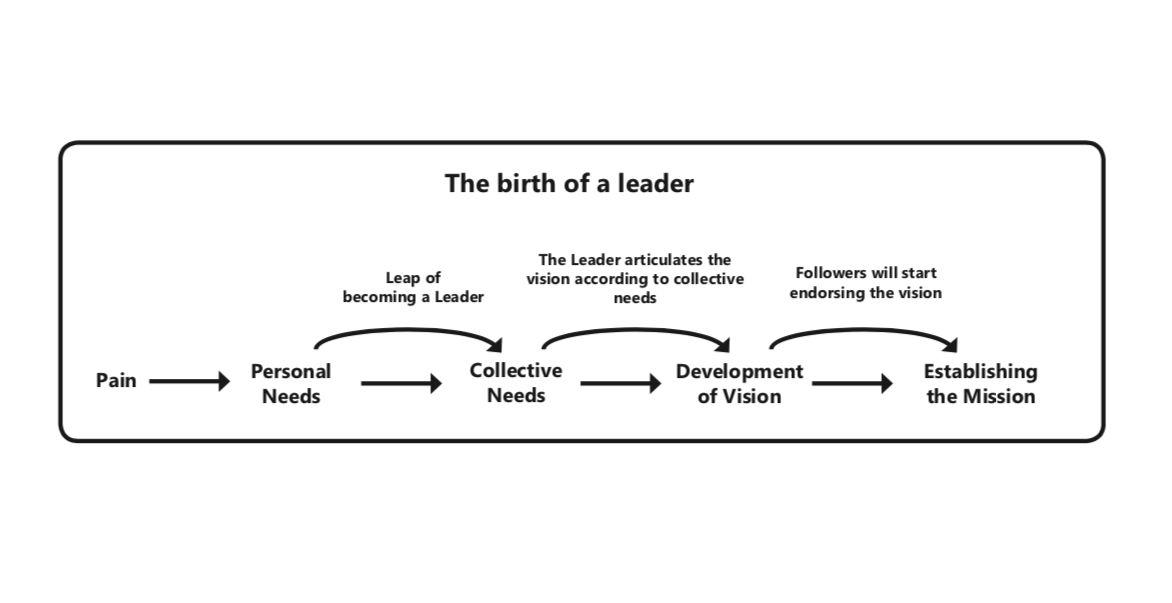Pain can be converted into a vision , but only if we allow ourselves to truly acknowledge, feel and endure that pain. Brushing off painful feelings is a way of pushing them into the subconscious instead of transforming them into an asset.
I would say that pain can certainly make a leader – it is often the essence behind one becoming a leader. This remark is better explained through the stories and experiences of some key iconic leaders in history.
Steve Jobs’ adoption, and his mother giving him away, on one hand created an immense pain due to that void of her absence, while on the other, it created an urge for him to connect as a young boy. Jobs was eventually able to transform this pain into a massive connection between communities through simplified technology which incorporates one of our easiest ways of learning: visual learning. His innovations made information technology simpler to reach the excluded, the illiterate. He simplified the black screen full of complex codes and letters into a visually pleasing software made up of applications which is easier to navigate. He chose pictures over words, made technology accessible to more people and allowed for them to connect with the rest of the world. From a psycho-emotional perspective, it can be interpreted that he fulfilled his personal need to connect through satisfying the collective need for communal connectivity through technology.
Even leaders who are considered to be immoral by some, such as Donald Trump, or by most, such as Adolf Hitler, developed their leadership motivation through their pain. On varying levels, they developed the perception that their race and ethnicity, and thus their pride, were being threatened. This was their pain. Were their ways of getting their vision realised correct? I don’t think so. Was their pain valid? Definitely!

Pain is a personal experience and therefore any form of pain is valid. It is the individual who chooses what is painful and what is not for oneself. When this pain is in sync with the pain of a huge part of society, then the acknowledgement of collective pain happens.
I believe that Trump’s pain resulted from the belief that white Americans had lost an ‘aristocratic’ and ‘dominant’ position within society, and through his Presidency he wanted to re-establish this sense of superiority. He sought to do so through absolute positivity that would charm people – a tactic he learned about and nurtured through the famous sermons of Pastor Peale, who was a prominent figure in Donald Trump’s childhood.
Adolf Hitler felt the pain of the disillusion of the German public opinion when they succumbed to the Treaty of Versailles in 1919. Dom Mintoff saw the pain that was caused by poverty in the Southern Harbour post World War II, Eddie Fenech Adami was pained as he saw that Malta was losing its Catholic values and was becoming increasingly secular. These leaders are highly distinguishable – they do not share common perspectives whatsoever, however, each one sought to reverse pain, sought to target the needs of the collective, and developed a vision for satisfying those needs. However, this concept is not only applicable to political leaders.
Freddie Mercury experienced pain through a feeling of exclusion, and his excellence in music was a reaction to the exclusion of his family from their motherland after the Zanzibar Revolution; he revolutionised music when he expressed his cry towards inclusion and acceptance through his songs. As a leader of pop music, he became the sensation and the hit that he is as a result of music that is full of pain, and which addresses the personal need for inclusion and acceptance – which need could easily be applied to the collective.
Leaders, irrespective of their varied perspectives and moral principles, all seek to act upon the needs of the collective and make a conscious decision to speak up to defend their ideas. They express the pain of people and start achieving a following, and these followers consequently establish them as their leader. The established leader would then start acting on behalf of the collective. A successful leader has the ability to take initiative and build up courage to speak one’s mind, contrary to being conventional, whilst possessing charisma, communication skills and integrity. Essentially, it can be argued that pain helps leaders to lead effectively and keep the group of people together following one vision. When leaders fail to recognise and accept their emotions, they end up being controlled by them. They become excessively critical and try to control every little thing, resulting in frustration towards themselves and those around them. On the contrary, leaders who accept their pain and personal needs apply them to the collective and continue to serve that vision, are capable of converting their vision into a mission that addresses collective needs. This is how one becomes a leader.
How to prioritise tasks when everything is important
Effective prioritisation can help establish the areas of focus that really matter.
Why active listening makes people better leaders
Being a good listener is considered among the most important leadership skills.
Leaders, what is your relationship with ‘rest’?
Understanding our attitudes and behaviours around rest can empower us to learn how to rest in a way that prevents ...
Say goodbye to your 60-hour work week
7 tips to stop business leaders from overworking.











